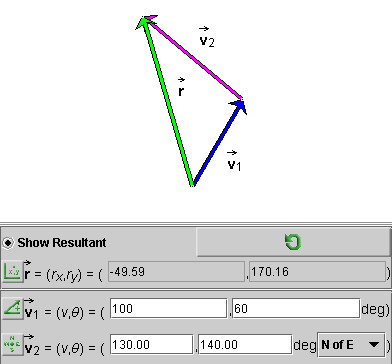 1,
enter a magnitude of 100 and an angle of θ = 60°
using the Polar (positive) mode. The data entry panel should look like Figure
1.
1,
enter a magnitude of 100 and an angle of θ = 60°
using the Polar (positive) mode. The data entry panel should look like Figure
1. This document shows you how to use this applet in a step-by-step manner. You should have the applet open; toggle back and forth between the ShowMe file and the applet as you work through these instructions.
If the applet window is not empty, clear it by pressing "Reset".
Enter first one vector and then another. For the first vector,  1,
enter a magnitude of 100 and an angle of θ = 60°
using the Polar (positive) mode. The data entry panel should look like Figure
1.
1,
enter a magnitude of 100 and an angle of θ = 60°
using the Polar (positive) mode. The data entry panel should look like Figure
1.

Figure 1
Remember that the applet lets you specify a vector in four ways. These four ways are explained in Help.
The only way to enter a vector in the applet window is via the data panel. However, once a vector has been entered that way and is displayed graphically in the window, the vector can be changed graphically by dragging its tip. The data panel will be updated accordingly. You can also move a vector, or an arrangement of several vectors, by clicking on a vector near its middle and dragging.
For the second vector,  2,
enter a magnitude of 130 and an angle of 140° in the Polar (positive) mode
or, equivalently, an angle of 140° N of E in the Navigational mode.
If the Navigational mode is chosen, the data entry panel for the second vector
should look like Figure 2.
2,
enter a magnitude of 130 and an angle of 140° in the Polar (positive) mode
or, equivalently, an angle of 140° N of E in the Navigational mode.
If the Navigational mode is chosen, the data entry panel for the second vector
should look like Figure 2.

Figure 2
After entering the two vectors, click the radio control button labeled "Show Resultant" to display the resultant (sum of the vectors). The resultant vector will be displayed in green and its two numerical specifiers will be displayed according to the mode chosen. In the snapshot in Figure 3, the Polar (positive) mode is used.

Figure 3
Click "Mode" three times to cycle to the Cartesian mode in which the resultant's (x, y) components are displayed. You get the display shown in Figure 4.

Figure 4
If you change either  1 or
1 or
 2 by dragging either vector
at its tip, the resultant is removed. The Show-Resultant radio control button
must be clicked again to show the new resultant. The same is true if the entire
arrangement of vectors is moved by dragging either
2 by dragging either vector
at its tip, the resultant is removed. The Show-Resultant radio control button
must be clicked again to show the new resultant. The same is true if the entire
arrangement of vectors is moved by dragging either  1
or
1
or  2.
2.
If you want to add a third vector to the first two, continue by entering its data in the third vector data panel, etc.
Click "Reset" to clear the applet window for a new set of vectors to be added.
Physics 20-30 v1.0
©2004 Alberta Learning (www.learnalberta.ca)
Last Updated: June 16, 2004